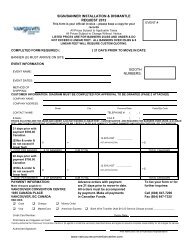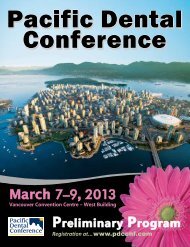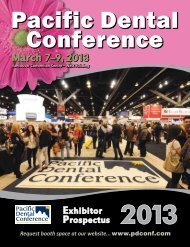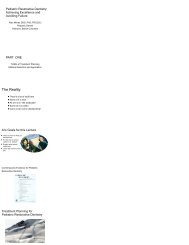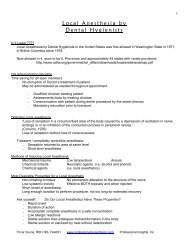download handout - Pacific Dental Conference
download handout - Pacific Dental Conference
download handout - Pacific Dental Conference
Create successful ePaper yourself
Turn your PDF publications into a flip-book with our unique Google optimized e-Paper software.
Numb and NumberEnhancing Your Local Anesthesia ToolkitArt DiMarco, DMD * Kathy Bassett, BSDH, RDH, MEd<strong>Pacific</strong> <strong>Dental</strong> <strong>Conference</strong>, March 7, 2013Program Overview: Updates and Potential Benefits• PharmacologySeptociane (4% articaine), 1:400,000 epi; 1.0 ml cartridge (Septodont)Prilocaine safety considerationsOrabloc (4% articaine), 1:100,000 epi. (Pierrel Research USA Inc.)Onset (OnPharma)OraVerse (Septodont)• TechniquesSelected Injection Review – Case studies• ArmamentariumWand STA system (Milestone)DentaVibe, VibraJect (BING Innovations)• Upcoming DevelopmentsKOVACAINE MIST (St. Renatus)LeEject® (Advanced Technology & Capital)Gebauer’s Pain Ease (Gebauer)Septociane (4% articaine), 1:400,000 epi. (Septodont)Case Study (1) - Articaine and Sulfite, Sulfur, Sulfonamide Conundrum 1History: A 54-year-old female reports a previous allergic response to sulfite antioxidants in arestaurant salad. No other issues of concern to the patient are reported. Health History:Unremarkable.Are modifications to treatment indicated? What would you do?Select the most appropriate answer(s):• No modifications necessary• May use any drug except articaine• Use only 3% mepivacine or 4% prilocaine plain• Use only 2% mepivacaine, 1:20,000 levonordefrinCase Study (2) – Sulfur Allergy 1History: A patient reports an allergic response to onions and discovered it was from the naturalsulfur content. Health History: Unremarkable.
Examples of Foods High In Sulfur (thiols):• artichokes, Jerusalem but not French• asparagus• bakery products containing whey, cysteine, eggsor enzymes• bean curd/tofu milk• bean sprouts• beans of all sorts• bok choy• broccoli• brussels sprouts• cabbage• carob• cauliflower• cheese of all sorts• chives• chocolate• coffee• collard greens• cream• daikon• dairy products• eggs• garlic• green beans• greens• horseradish• jicama• kale• leeks• lentils of all sorts• milk from any animal• miso soup• onions• papaya (slightly)• peas• peanuts• pineapple (slightly)• radishes• rutabaga• sauerkraut• shallots• sour cream• soy cheese• soy milk• spinach• split peas• tempeh• tofu• turnip• turmeric (though not high in thiols, it is reallygood at raising thiol levels)• whey• yeast extractCase Study (3) - “Sulfa” Allergy”History: A patient is taking sulfa drugs for a urinary tract infection. No other issues of concern arereported. Health History: Unremarkable.Facts: 1• Sulfa drugs = sulfonamide antibacterials• Articaine - No interference with sulfonamide antibacterial action• Articaine - No cross-allergenicity with sulfonamidesAre modifications to treatment indicated? What would you do?Examples of LA drugs that can interfere with the antibacterial action of the sulfonamides:• Benzocaine• Tetracaine• Butamben (butyl aminobenzoate)• Procaine
Facts: 2• Ester local anesthetics are known as paba-derivatives• Metabolites of drugs that are paba-derivatives “may antagonize sulfonamide antibacterials,especially if significant quantities have been absorbed over prolonged periods.Articaine Update 3Articaine does have a sulfur atom, but . . .• The sulfur is firmly bound within the thiopene ring and cannot beantigenic• Even during its biotransformation and elimination, the sulfur does not dissociateIn Terms Of CNS Toxicity and Overall Efficacy . . .• Articaine is safer than lidocaine?• Articaine is as effective, or more effective, and more durable, depending on technique• Articaine is more potent and has a 50% greater protein binding capability than lidocaineDrug Protein Binding Relative PotencyProcaine 5.8 1Mepivacaine 78 4Psilocin 55 4Lidocaine 64 4Articaine 94 5Bupivacaine 95 16Adapted from Ruetsch YA, Boni T, Borgeat A: From cocaine to ropivacaine: the history of localanesthetic drugs (2001): Current Topics in Medicinal Chemistry, p. 179.Articaine & Paresthesia• Avoid IA blocks, or do we? 4• Avoid more than ½ cartridge in the palate, or do we? 4• High blocks OK – no increased incidence evidence 5• Mostly: deposit slowly - limit volumes per injection• Use decreased volumes (same mg as lidocaine, articaine is 4%)• Deposit slowly (½ c cartridge per minute for 4% drugs)
Articaine in Buccal Infiltrations of the MandibleComparison of articaine & lidocaine in buccal infiltrations for posterior mandibular anesthesia. 6• 2% lidocaine, 1:100,000 epinephrine 45% – 67%• 4% articaine, 1:100,000 epinephrine 75% - 92%Use of 4% articaine, 1:400,000 epinephrineDo dilutions of 1:400,000 epinephrine effectively slow the systemic absorption of articaine?Are they as effective as or effective enough compared to:• 4% articaine, 1:100,000 epinephrine• 4% articaine, 1:200,000 epinephrine• 2% lidocaine, 1:100,000 epinephrineSo . . . does plain articaine work? 7• 88 patients in need of single tooth mandibular extractions received IA blocks with 4%articaine with either 1:100,000 epinephrine (n = 41) or without epinephrine (n = 47)• Researchers compared the differences in onset as well as length of soft tissue anesthesia.They also compared volumes of solution required, the need for a second injection, painwhile injecting, pain during treatment, postoperative pain, and complications.Study Results:• Sufficient anesthesia developed for all extractions in both groups.• Those receiving 4% articaine with 1:100,000 epinephrine, had a significantly faster onset(7.2 min vs. 9.2 min) and a longer duration of soft tissue anesthesia (3.8 h vs. 2.5 h).According to the study . . . there was no significant difference in:• the volume of solution needed• the need for a second injection• the pain of injection• the experience of pain during the procedure• post-operative analgesia• the type or rate of complications
But … neither 4% articaine plain nor 4% articaine with 1:400,000 epinephrine is currentlyavailable … so, what else might work?• 3% mepivacaine to anesthetize the nerve• Then add, very slowly, a small volume of a drug with 1:200,000 epinephrine – keep itminimal• The patient must let you know immediately if they feel any palpitations during thedeposition.• The area will be numb from the mepivacaine, decreasing the chance that anxiety mightresult in endogenous epinephrine spikes, due to painful stimuliLevonordefrin versus Epinephrine“Clinically, the higher concentration of levonordefrin makes it equipotent to epinephrine in clinicaland systemic effects, so 1:20,000 levonordefrin offers no clinical advantage over 1:100,000epinephrine.” 8When can levonordefrin be of benefit?1. 2% mepivacaine, 1:20,000 levonordefrin is a substitute for 2% lidocaine,1:100,000 epinephrine2. When some patients experience palpitations after even minimal amounts of epinephrine areadministered, levonordefrin may avoid the same reaction3. Whenever epinephrine is contraindicated due to other drugs a patient is takingCase Study (4) - Local Anesthetics & NursingHistory: A patient is a nursing mother who is concerned about exposing her baby to anestheticdrugs. She has read that it is not known whether or not local anesthetics pass into breast milk butshe wants to avoid it. No other issues of concern to the patient are reported. Health History:UnremarkableFacts: Most drugs are available in breast milk once introduced but little harm is predicted. 9Product information generally states that caution must be exercised when nursing followingadministration of local anesthetics. 10Use of Articaine in nursing women:• Very short half-life• The metabolic products are inactive. 11• Articaine is a good choice for reassurance.• Can nurse 4 hours after administration. 11
Septodont uses figures in their product information that are based on maximum dosing andstates that:“Nursing mothers may choose to pump and discard breast milk for approximately 4 hours (basedon plasma half-life) following an injection of Septocaine® (to minimize infant ingestion) and thenresume breastfeeding.” 11New Articaine Formulation - Orabloc• A new purer form of articaine. Aseptically packaged.• Not end-sterilized which can decrease the potency of the cartridge contents• Increases shelf life from 18 to 24 monthsMade in Italy; Health Canada- and FDA-approvedBuffering - OnsetFacts:• An increase of one point (pH) represents an exponential decreasein hydrogen ions.• A higher pH promotes the formation of neutral base molecules.More neutral base molecules increase effectiveness & decreaseonset.• Currently approved for use with lidocaine, only• The more acidic the solution, potentially the more painfulHealth Canada- and FDA- approved - Caveat: Newer solutions (with vasoconstrictors) are lessacidic than older solutions yet the recommended volume of buffering relates to lidocaine only, notthe age of the cartridge.Buffering: Does faster onset of anesthesia (i.e., early labial and mental signs & symptoms) indicatean increased likelihood of successful IA block? 12• Following a lower block, lip numbness is a primary indicator of success. 12• Faster onset away from the lip (i.e., molar areas), not so much.Note: Although discussions of “off label” use with other LA drugs may be found, the manufacturercurrently only identifies use of Onset with lidocaine / epinephrine.Anesthesia Reversal - OraVerse ® (phentolamine mesylate) 13Is there a way to decrease the duration of numbness?• Vasodilator• Non-selective, reversible α-adrenergic blocker used in hypertensive emergencies inducedby drugs such as cocaine• Approved on patients 6 and up (not below 6 . . . yet)• Lip recovery times reduced from 1.0 – 1.5 hours• One or less (some recommend ½) cartridge per site
Adverse Reactions 13• similar to sham injection reactions• no serious events reported• optimal use may require some modificationsCase Studies: Discussion on Inadequate AnesthesiaCommon Causes of Anesthetic Inadequacy• Lack of or faulty anatomic assessment• Physical barriers• Physiology• Lack of comfort with alternative techniques• Tachyphylaxis• Ineffective or expired cartridges• Accessory or aberrant innervationsCase Study (5) - Inadequate Mandibular AnesthesiaHistory: A 22-year-old male received an IA with 2% lidocaine, 1:100,000 epinephrine forrestorative treatment of #18 and #22. Minimal anesthesia occurred, even after a second injectionwith the same drug. Health History: Unremarkable.What would you do? Select the most appropriate answer(s):• Wait longer, expecting anesthesia to develop• Re-evaluate your technique and repeat the injection a 3 rd time• Repeat the injection a 3 rd time but adjust the depth of penetration• Repeat the injection a 3 rd time but use 2% mepivacaine, 1:20,000 levonordefrin• Give a supplemental:• PDL injection• Intraosseous• Gow-Gates• Akinosi (Vazirani-Akinosi)Inadequate Anesthesia: Inferior Alveolar Nerve DiscussionFacts:1. The mandibular foramen is below a point that is 10 mm above the mandibular occlusal plain84% of the time. 142. The mandibular foramen is below a point that is 15 mm above the mandibular occulsal plain96% of the time. 143. The trunk of the IA nerve is often located several millimeters medial to the foramen in thislocation (the horizontal axis 15 mm above the mandibular foramen).4. A short needle length (typically 21 mm) may approximate the distance from thepterygomandibular raphe to the IA nerve trunk when it is approximately 15 mm above themandibular occlusal plane. Depositing solution higher is more likely to place it above theforamen.Caveat: This can increase risk due to variations in vascular patterns. 15
Case Study (6) - Inadequate AnesthesiaHistory: A 22-year-old female presents with an endodontic emergency involving tooth #31.A right IA was administered with 2% lidocaine, 1:100,000 epinephrine, which the patient reportedas very uncomfortable; and the pain persisted despite the injection. Health History:Unremarkable.You decide to re-inject. What might you use? Select the most appropriate answer(s):• Articaine• Intraosseous• Bupivacaine• Buffered bupivacaine• Buffered articaineCase Study (7) - Inadequate Anesthesia - IA blockHistory: A 28-year-old female is scheduled for restorations in the lower left quadrant and receives 2cartridges of 2% lidocaine, 1:100,000 epinephrine for an IA. Insufficient anesthesia develops despiteexcellent technique and appropriate pre-anesthetic assessment. Health History: Unremarkable.Repeating the same injection usually works but hasn’t worked in this instance.• What are the potential advantages of administering a plain drug (without vaso)?• What are the potential concerns?Advantages -Concerns -Discussion on administering 3% mepivacaine after 2% lidocaine, 1:100,000 epi:• While controversial, the argument: the mepivacaine solution has a much higher pH comparedto lidocaine with a vasoconstrictor. Small increases in the pH at the nerve membrane, even ifvery transient could potentially increase the efficacy of the drug.• 3% drugs have 50% more local anesthetic molecules per volume.• Must consider the increased dose per volume when calculating toxicity• There is also a benefit from the epinephrine vasoconstriction already in effect, essentiallycombining the two drug actions in this manner: 3% mepivacaine, 1:100,000 epinephrine.• Although the benefit is speculative and unknown, patients can be informed that a safe butstronger drug is being used (to perhaps overcome psychological factors).Why 3% Mepivacaine Versus 4% Prilocaine plain?
Prilocaine is supplied in 4% plain and 1:200,000 epinephrine formulations. The plain formulationworks well in this scenario; however, we chose mepivacaine for several reasons, including itssimilarity to lidocaine including its dosing recommendation (lidocaine 7.0 mg / kg; mepivacaine6.6 mg / kg) as well as literature including FDA bulletin information regarding benzocaine andprilocaine administration. 16,17,18According to the FDA: 16Certain underlying conditions may predispose an individual to the development ofmethemoglobinemia if benzocaine or prilocaine is administered. The FDA Advisorystates that, “…patients with underlying breathing problems, such as asthma oremphysema, patients with heart disease, and those who smoke may be more susceptible”Case Study (8) - Inadequate Anesthesia - IA blockHistory: A 61-year-old female presents with pain in tooth #19, a bridge abutment. She has anappointment with the endodontist the next day but “the pain is horrible” and narcotic pain medsare not helping. She pleads, "I have to have some relief." She mentions that she is sensitive toepinephrine. Health History: Unremarkable.You’ve decided to administer drug(s) that provide long-acting anesthetic relief to keep herout of pain as long as possible. What could you use? Select the most appropriate answer(s):• 0.5% bupivacaine (Marcaine), 1:200,000 epi• 4% articaine, 1:200,000 epi.• 3% mepivacaine + 0.5% bupivacaine, 1:200,000 epi• 4% Prilocaine, 1:100,000Case Study (9) - Mandibular Anesthesia After PSAHistory: A 53-year-old female is appointed for restorative treatment of #2 and #3. She receives aPSA and an infiltration over the MB root of #3. Following the injections, mandibular anesthesiadevelops. The patient asks if you’ve decided to work on a lower tooth, instead. Health History:Unremarkable.What has occurred? Select the most appropriate answer(s):• The injection was too posterior to the target site• The injection was too lateral to the target site• The injection was too inferior to the target siteCase Study (10) – Routine Inadequate Anesthesia IHistory: A 45-year-old male presents for restorative treatment of #4. He reports “no one has everbeen able to numb #4 previously”. He receives two infiltrations over #4 of 4% articaine,1:100,000 epinephrine. No anesthesia develops (including soft tissue). Health History:Unremarkable.
Which injection could you try next? Select the most appropriate answer(s):• IO• PDL• AMSA• Maxillary (V2) nerve block• IntraosseousCase Study (11) – Routine Inadequate Anesthesia IIHistory: A 21-year-old male presents for restorative treatment of #19, #20, and #23.Health History: Unremarkable.As you read the schedule for the day … you recall: "This patient's been in twice and I haven’tbeen able to get anything done. Everyone in the office has tried to get him numb, and and no onehas been able to anesthetize him. IAs, Gow-Gates blocks, Akinosis have been tried. What’s next?”Treatment Hx - Past injections with: 2% lidocaine, 1:100,000 epinephrine + 3% mepivacaineplain and 4% articaine, 1:100,000 epinephrine. Rescheduled twice, the second time at a differenttime of day (diurnal pharmacological consideration). Third Appt. an unsuccessful Gow-Gateswith 4% articaine, 1:100,000 epinephrine.Case Study (12) – Fear of Palatal InjectionsHistory: A 35-year-old female presents for pre-surgical periodontal therapy (maxillary rightquadrant). The Tx plan includes 2% lidocaine, 1:100,000 epinephrine and palatal anesthesia.When she arrives, the patient begs you not to use palatal injections. You explain that palatalanesthesia is necessary for comfort and successful therapy. She finally agrees but begs you to limitthe number of “pokes” in the palate. Health History: Unremarkable.Are there ways to avoid palatal injections entirely?• Buccal infiltrations with articaine (at times)• Interpapillary injections• Intraseptal injections• Maxillary (V2) nerve blockCase Study (13) – Routine Inadequate Mandibular Anesthesia: Saving the DayHistory: A 24-year-old male presents for restorative treatment of #27, #28, and #30. The patientreports: "I never get numb in my lower jaw. Last time they gave me at least seven shots and it stillwasn't numb." Health History: Unremarkable.
What would you want to know? Questions to ask:• Have you ever received injections along the gums next to your teeth?• Have you ever had to open wide, stay wide open during the injection, and then remain openfor a bit after the injection?• Do you have difficulty keeping your mouth open for long periods of time or have jaw pain?• Were you ever asked to close your mouth before an injection?• Were you ever told that a small hole was made in the bone for anesthetic access?• Did anyone ever put a small electrode on your any of your teeth (send a small shock) to testfor numbness?The patient answered that he remembered "shots on the gums" and a lot of pain indicating that hehad had some traumatic and likely ineffective PDLs since he's "never been numb" in the lower jaw.He did not remember closing before an injection, being told that he had had a hole drilled in thebone, or being asked to keep his jaw open after an injection. He also did not remember a pulptester being used.Case Study (14) – Inadequate to Proactive AnesthesiaHistory: A 35-year-old female is scheduled for root canal therapy on #30 (her third RCT). She isanesthetized with 2% lidocaine, 1:100,000 epinephrine and 4% articaine, 1:100,000 epinephrine.After the procedure she comments: "That was the best root canal I've ever had" (Is she referring toendodontic expertise?). Health History: UnremarkableCase Study (15) – Limiting EpinephrineHistory: A 62-year-old male is scheduled for a restorative procedure. Health History:Medication (propranolol - non-selective beta blocker), BP - 134/88Are there any modifications or treatment considerations for the use of LA?Which anesthetic is the safest?Case Study (16) – Compromised Liver FunctionHistory: A 58 year-old male is scheduled for a restorative procedure. Health History: HepatitisC, cirrhosis of the liver, medications - multiple for cardiovascular disease and Type 2 diabetes.Are there any modifications or treatment considerations for the use of LA?Which anesthetic is the safest?Fact: Nonselective beta blockers + epinephrine can cause precipitous spikes in blood pressure insome individuals that usually produce only headaches in others, if anything, but can lead tocatastrophic strokes in others. 19
Did you also know that 19 . . . ". . . patients on beta-blockers who develop anaphylaxis are likely to be resistant to thetherapeutic effects of epinephrine used to treat the anaphylaxis."* ". . . it is generally assumed that all beta-blockers can inhibit the response to epinephrine inanaphylaxis."* "There also is evidence that patients on beta-blockers have an increased incidence and severityof anaphylaxis, . . ." 20Updates and Interesting Stuff!• ml cartridges (4% articaine)• Wand STA system• DentaVibe• VibraJect• Buzzy• Quick SleeperUpcoming Developments – What’s On the Horizon?• Kovacaine Mist• LeEject• Gebauer's Pain EaseInformal Case Discussion 1:Your next patient "hates" palatal injections and will not let you administer "one more shot in theroof of my mouth."What can you do?Informal Case Discussion 2:A dental assistant working in your office sticks herself with a needle while discarding it in asharp's container.Is there a safer way to dispose of needles?Informal Case Discussion 3:It takes too long waiting for gel topicals to work. Even one minute seems like an eternitysometimes.Is there a fast-acting topical on the market?
MRDs for North AmericaLA Drug mg/kg mg/lb MRD (in mg)Articainew/ vaso. 7.0 3.2 none listedBupivacainew/vaso.* 2.0 0.9 90Lidocainew/vaso. 7.0 3.2 500Mepivacainew/o vaso. 6.6 3.0 400w/vaso. 6.6 3.0 400Prilocainew/o vaso. 8.0 3.6 600* none listed by USFDAThank you for joining us!
References1. Becker DE, Reed KL (2006): Essentials of local anesthetic pharmacology, Anesthesia Progress, 53(3):98-109.2. Anesthetics (topical), drug monograph, http://www.drugs.com/mmx/benzocaine.html, accessed 4-12-12.3. Bassett KB, DiMarco AC, Naughton DK (2010): Local Anesthesia for <strong>Dental</strong> Professionals, Upper SaddleRiver, NJ, Pearson Prentice Hall.4. Malamed SF (2013): Handbook of Local Anesthesia, 6 th ed., St. Louis, Missouri, Elsevier Mosby.5. Hawkins MJ (2009): Efficacy and paresthesia in dental local anesthesia, The Academy of <strong>Dental</strong>Therapeutics and Stomatology, PennWell CE.6. Robertson D, Nusstein J, Reader A, Beck M, McCartney M (2007). The anesthetic efficacy of articaine inbuccal infiltration of mandibular posterior teeth, Journal of the American <strong>Dental</strong> Association, 138(8):1104-1112.7. Kämmerer PW, Palarie V, Daubländer M, Bicer C, Shabazfar N, Brüllmann D, Al-Nawar B (2011): 4%Articaine with epinephrine (1:100,000) and without epinephrine in inferior alveolar block for toothextraction: double-blind randomized clinical trial of anesthetic efficacy. Oral Surgery Oral Medicine OralPathology Endodontics, July 6.8. Hargreaves, K.M., Cohen, S. (2011): Cohen’s Pathways of the Pulp, 10 th edition, St. Louis, Mosby Elsevier.9. Giuliani M, Grossi GB, Pileeri M, Lajolo C, Casparrini G (2001): Could local anesthesia while breastfeedingbe harmful to infants? Journal of Pediatric Gastroenterology and Nutrition, 32(2): 142-144.10. Septocaine, Full Prescribing Information, http://www.drugs.com/pro/septocaine.html accessed 4-12-12.11. Oertel R, Rahn R, Kirch W (1997): Clinical pharmacokinetics of articaine, Clinical Pharmacokinetics,33(6): 417-425.12. Kanaa MD, Whitworth JM, Corbett IP, Meechan JG (2007): Is onset time of subjective lip numbness apredictor of mandibular block success? Anesthesia Progress, 54(3):131-149.13. Yagiela JA (2011): What’s new with phentolamine mesylate: a reversal agent for local anesthesia?Society for the Advancement of Anesthesia in Dentistry Digest 27:3-7.14. Gow-Gates GAE (1973): Mandibular conduction anesthesia: a new technique using extraoral landmarks.Oral Surg. 36(3): 321-328.15. Jeske AH, Blanton PL (2002): Misconceptions . . . involving dental local anesthesia, Texas <strong>Dental</strong> Journal119(4): 296-307.16. Advisory on Benzocaine Sprays and Methemoglobinemia.FDA Patient Safety News. Available at:www.accessdata.fda.gov/scripts/cdrh/cfdocs/psn/printer.cfm?id=418. Accessed September 26, 2007.17. Knobeloch L, Goldring J, LeMay W, Anderson H. Prilocaine-induced methemoglobiemia— Wisconsin,(1993). MMWR Morb Mortal Wkly Rep. 1994;43:655-657.18. Bassett K, DiMarco AC. Safety first. Dimensions of <strong>Dental</strong> Hygiene. 2007;5(10): 20-25.19. Horn JR, Hansten PD (2009): The dangers of beta blockers and epinephrine, Pharmacy Times, May, p.31.



